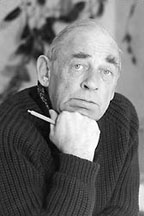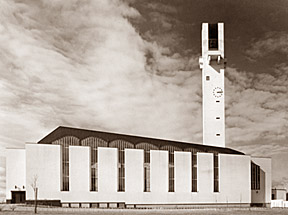The
Alvar Aalto Story
by Bob Brooke
 If
we accept the theory of design that the form of an article should be
determined by its use we have gone some way towards appreciating the
work of Finland's most distinguished architect, Alvar Aalto, but that
simple definition of functionalism does not reveal the depth of Aalto's
artistic achievement. Functionalism was a phase in his career, a step on
the way to his expression of the organic relationship between man,
nature and buildings. It was Aalto's ability to coordinate those three
components that discloses the beauty of his work. Aalto spoke of his art
(building art he called it) as a synthesis of life in materialized form. If
we accept the theory of design that the form of an article should be
determined by its use we have gone some way towards appreciating the
work of Finland's most distinguished architect, Alvar Aalto, but that
simple definition of functionalism does not reveal the depth of Aalto's
artistic achievement. Functionalism was a phase in his career, a step on
the way to his expression of the organic relationship between man,
nature and buildings. It was Aalto's ability to coordinate those three
components that discloses the beauty of his work. Aalto spoke of his art
(building art he called it) as a synthesis of life in materialized form.
Alvar Aalto, born Hugo
Alvar Henrik Aalto in 1898 in the village of Kuortane, situated between
the lake country of central Finland and the flat farmlands of the
western province of Ostrobothnia, was the eldest of three children in a
family that belonged to the middle class of municipal civil servants.
His father was a surveyor. When Aalto was five the family moved to
Jyväskylä, a town that will forever be associated with his name. It
was to be his home for the next 24 years and contains more of his
buildings than any other place in the world. He designed 70 buildings
for the town and its surroundings, 37 of which were realised. After
leaving school Aalto went on to study at the Helsinki University of
Technology where he graduated with a degree in architecture in 1921.
Back in Jyväskylä, he opened his first architectural office in 1923.
The following year he married architect Aino Marsio. Their honeymoon
journey to Italy sealed an intellectual bond with the culture of the
Mediterranean region that was to remain important to Aalto for the rest
of his life.
In Pursuit of Artistic
Harmony
In 1927 the Aaltos moved
to the southwestern city of Turku to carry out some important
commissions and from there to the Finnish capital, Helsinki, in 1933.
During his time in Turku Aalto's most significant design was for the
Paimio Sanatorium, a building that quickly elevated him to the status of
master of heroic functionalism, a genre that he was soon to walk away
from in his pursuit of artistic harmony through a synergy encompassing
people, their environment and the buildings in which they live.
 "In artistic
creation, conscious respect for the problems of our times includes a
magnificent goal: that of taking industrialism step-by-step to where it
will eventually have to arrive–at the status of a harmonious cultural
factor," said Alvar Aalto in 1928. "In artistic
creation, conscious respect for the problems of our times includes a
magnificent goal: that of taking industrialism step-by-step to where it
will eventually have to arrive–at the status of a harmonious cultural
factor," said Alvar Aalto in 1928.
This perception of
organic links between people, nature and buildings matured in the late
1930s when he designed the Villa Mairea, one of the most admired private
residences of modern architecture. "At its best, abstract art is,
as it were, a result of a process of crystallisation," Aalto said.
"That may explain why it can be understood purely and solely
through emotion, although in it and behind it are constructive thoughts
and a fabric of human tragedy."
Aalto's later
masterpieces include the municipal building in Säynätsalo, completed
in 1952, and the Vuoksenniska Church (1959).
Alvar Aalto, the Man
 Exceptionally broad in
scope, his work ranged from buildings and town plans to furniture,
glassware, jewellery and other forms of art. He was a cosmopolitan whose
skills in various languages made travelling abroad and public speaking
easy. When he was about to leave home to study in Helsinki his father
gave him a piece of advice that was good but perhaps superfluous: "Alvar,
always be a gentleman." His children describe him as a man of even
temper who avoided becoming annoyed, a man who was usually able to find
a compromise solution when differences arose with clients. His
tactfulness and charm would no doubt have resolved the controversy over
the marble surfaces of Finlandia Hall, his last great building in
Helsinki, an issue that arose nearly twenty years after his death. Exceptionally broad in
scope, his work ranged from buildings and town plans to furniture,
glassware, jewellery and other forms of art. He was a cosmopolitan whose
skills in various languages made travelling abroad and public speaking
easy. When he was about to leave home to study in Helsinki his father
gave him a piece of advice that was good but perhaps superfluous: "Alvar,
always be a gentleman." His children describe him as a man of even
temper who avoided becoming annoyed, a man who was usually able to find
a compromise solution when differences arose with clients. His
tactfulness and charm would no doubt have resolved the controversy over
the marble surfaces of Finlandia Hall, his last great building in
Helsinki, an issue that arose nearly twenty years after his death.
Is there an essentially
Finnish element in Aalto's architecture? Many who know Finland's
cultural heritage would see one. They see in his work the same metaphors
of nature and the Finnish experience as in the music of Jean Sibelius or
the creations of designers such as Wirkkala, Sarpaneva and many others.
But Aalto's importance as an architect goes beyond the borders of his
homeland. Like all great art his has the power to evoke feelings and the
right to its own place in the world's cultural heritage.
Aalto Live On
Aalto, who died in 1976,
was one of the 20th Century's landmark figures in the renewal
of architecture and interior decoration. More has been written about him
and his work than about any other architect in the post-war period. He’s
so unique and inimitable as an architect that no "Aalto
School" ever had a chance of emerging. Yet he has left an indelible
impression on contemporary architectural thinking and design.
"National
distinctiveness is ultimately of no significance in this matter, because
he who is great dares to be universal, but his own persona will show
through in his work," said Aalto in 1929.
He later added, "I
do not write, I build. The Creator made paper for drawing on. Everything
else, at least to me, is an abuse."
Read
more about Alvar Aalto designs.
< Back to Ageless
Designs
Go to Finnish Sauna > |